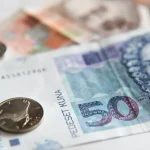December 20, 2023 – Looking at current trends in economic activity, as well as the 2024 financial forecast for Croatia, the Croatian National Bank (CNB) is quite optimistic.
In the latest projections, writes Poslovni, the CNB reduced the estimate of economic growth for this year to 2.6 percent (compared to 2.9 percent from the September forecasts), however the reason for this is not the current economic dynamics, but a revision of the data of the National Bureau of Statistics on the GDP, by which the growth in the first half of the year was corrected downwards.
CNB’s rapid assessment models suggest that the last quarter of the year will be marked by a renewed acceleration of economic activity – with the growth of 0.8 percent on a quarterly basis and 3.5 percent compared to the last quarter of last year.
All in all, while the recovery in the eurozone has been postponed until the beginning of next year, the CNB expects somewhat stronger GDP growth for Croatia next year than until recently; instead of 2.6 percent in real terms, in 2024 they are now counting on growth of 3 percent.
Both for this year and for the next, the expectations of a strengthening of individual consumption have been increased, with the fact that this year’s growth will be contributed more than the initial forecasts by the growth of investments and government spending.
In contrast, inflation – both headline and core – is decelerating faster than until recently expected. Thus, it is now calculated that the average inflation (measured by the harmonized, internationally comparable index, HICP) will amount to 8.4 percent this year, and not 8.8, which was estimated three months ago.
Next year, the growth rate of the general price level should be more than halved, to 4 percent. A somewhat faster reduction is shown above all in food inflation, but also in the service segment, where inflation was particularly pronounced and did not fall supported by the tourist season, a gradual reduction is finally being observed, says Governor Boris Vujčić, adding that next year lower price inflation is expected for all components.
Within the euro area, food and services were the components that maintained the difference between inflation in Croatia compared to the eurozone average (according to current estimates, 5.4 percent is expected for 2023), but currently there is a higher contribution from energy in Croatia, while the inflation gap decreased in food and services, the CNB points out.
In this regard, the governor reminded that energy and food in Central and Eastern Europe have a greater weight in the consumer basket than in the rest of the eurozone. However, he added that the growth in the general level of consumer prices from mid-2021 onwards in other CEE countries (except Slovenia) was higher than the 22.9 percent recorded in that period in our country.
The governor touched on a topic related to inflation that was particularly highlighted in the first half of the year, namely the issue of the contribution (increase) of profit margins to price growth. The data show, he says, that the contribution of unit profits is decreasing, as expected, while the contribution of wage growth to the GDP deflator is still high.
As a potential risk of realizing the expected slowdown in inflation, he apostrophized precisely the risk that the growth of unit labor costs is not absorbed through unit profits to the extent that it is calculated. Be that as it may, with personal consumption remaining the mainstay of growth, next year the central bank again expects a positive sign of both exports and imports.
Even in the horizon of three years, the basic scenario predicts growth rates that exceed the pre-pandemic ones (for 2025, the projections are at 2.7%, and the year after that at 2.6%). In addition to the fact that this means higher rates than the eurozone average, economic growth rates below the pandemic level are expected on average for the eurozone members in the next three years.
On the labor market, on the other hand, nothing significant has changed. In addition to the long-term trend of growth in employment and decline in unemployment, there is also a shortage of available labor, and all of this affects the movement of wages.
After real wages decreased in 2022 due to the high rate of inflation (i.e. more than the nominal growth of wages) from the second quarter of this year they entered positive territory in real terms as well. And among the first in the eurozone, says Vujčić. In addition, they expect a continuation of their growth in the CNB in the next three years, with around 3.6 percent this year.
When it comes to the monetary sphere, the policy of interest rates will depend on the projection of inflation in the future, but also on the power of transmission to domestic loans. At the moment, the cycle of interest rate growth has stopped. The conditions are restrictive enough that it is realistic to expect a reduction in the inflation rate without an additional increase in interest rates.
“It may be too early to talk about when it will start to decrease, but if our projection of a decrease in inflation is realized, at some point next year we could expect the beginning of a trend of falling interest rates. I can’t say when, we will look at the data and as it comes, we will make decisions, but next summer is a period when we will know more and when such a thing can be expected, says Vujčić. But with a note that “there are always risks for such projections”.
Less Susceptible to Shocks
Recalling the positive effects of joining the eurozone, he stated that interest rates in Croatia are lower than in the eurozone, transaction costs have disappeared, and Croatia is much less susceptible to economic shocks in times of crisis.











